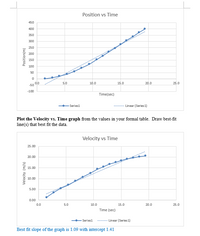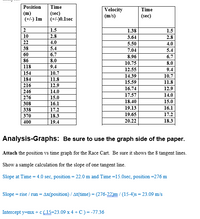Question
a) What quantity name is represented by the slope of your v vs t best-fit line? Hint: Look at the slope units for a clue. Remember that a quantity is a variable and not a unit. For example position is a quantity name, whereas cm or meters are units for the position quantity.
b) What is the quantity name represented by the vertical axis intercept on the velocity vs. time graph? Is it the value that you expected based on how you were directed to release the cart? If not, what should you have done differently?
c) Show your calculation for the method 2 velocity. Explain how it compared to the reading from your velocity vs. time graph.

Transcribed Image Text:Position vs Time
450
400
350
....**
300
250
200
150
100
50
0.0
-50
5.0
10.0
15.0
20.0
25.0
-100
Time(sec)
Series1
Linear (Series 1)
Plot the Velocity vs. Time graph from the values in your formal table. Draw best-fit
line(s) that best fit the data.
Velocity vs Time
25.00
20.00
..........
15.00
10.00
5.00
0.00
0.0
5.0
10.0
15.0
20.0
25.0
Time (sec)
Series1
Linear (Series 1)
....
Best fit slope of the graph is 1.09 with intercept 1.41
(w)uojijsod
(s/w) Aapojan

Transcribed Image Text:Position
Time
Velocity
(m/s)
Time
(m)
(+/-) Im
(sec)
(+/-)0.1sec
(sec)
2
1.5
1.38
1.5
10
2.8
3.64
2.8
22
4.0
5.50
4.0
38
5.4
7.04
5.4
60
6.7
8.96
6.7
86
8.0
10.75
8.0
118
9.4
12.55
9.4
154
10.7
14.39
10.7
184
11.8
15.59
11.8
216
12.9
16.74
12.9
246
14.0
17.57
14.0
276
15.0
18.40
15.0
308
16.1
338
17.2
19.13
16.1
18.3
19.65
17.2
370
400
19.4
20.22
18.3
Analysis-Graphs: Be sure to use the graph side of the paper.
Attach the position vs time graph for the Race Cart. Be sure it shows the 8 tangent lines.
Show a sample calculation for the slope of one tangent line.
Slope at Time = 4.0 sec, position = 22.0 m and Time =15.0sec, position =276 m
Slope = rise / run = Ax(position) / At(time) = (276-22)m / (15-4)s = 23.09 m/s
+c(15=23.09 x 4 +C)=-77.36
Expert Solution
This question has been solved!
Explore an expertly crafted, step-by-step solution for a thorough understanding of key concepts.
Step by stepSolved in 4 steps

Knowledge Booster
Similar questions
- A plane flying at 78.2 m/s [W32°S] takes 42 seconds to change its velocity to 78.2 m/s [S32°E]. a) Solve for the change in velocity of the plane algebraically, resolving vectors into their x- and y-components. b) What was the average acceleration of the plane over this time interval? c) Explain why the speed of the plane didn't change and yet the plane underwent acceleration. Please label sketches with events as well as GRASS and explanations to show your work. Please label triangle sides. Remember to have the magnitude rounded to a reasonable number of sig figs, the unit and the direction (if needed) in your answers.arrow_forwardA student stands at the edge of a cliff and throws a stone horizontally over the edge with a speed of vo = 20.5 m/s. The cliff is h = 26.0 m above a flat, horizontal beach as shown in the figure.arrow_forwardProblem 1: An object is launched off the top of a 45-m tall building with velocity of 70.9 m/s in the horizontal direction (no angle with respect to the horizontal). Pai. (a) In the space below, explain how you would find the time that the object is in the air. (Type the equation(s) you would use and the variable(s) you would solve for. Describe any other important steps. Do not show calculations or the numeric answer.)arrow_forward
- Please box all answersarrow_forwardVectors: a.) Can you find two vectors with different lengths that have a vector sum of zero?Explain your answer in detail. b.) Can the magnitude of an object’s displacement be larger than the distance it hastraveled? What is the condition for them being equal. Explain your answers in detail.arrow_forwardA bus makes a trip according to the position-time graph shown in the drawing. What is the average velocity (magnitude and direction) of the bus during each of the segments A, B, and C? Express your answers in km/h. The scale for the time axis is 2 h per increment, and scale for the velocity axis is 210 km per increment. (Indicate direction by the sign of the velocity.) segment A segment B segment C km/h km/h km/h Show My Work (Optionall Time (h)arrow_forward
- A woman stands at the edge of a cliff and throws a rock horizontally over the edge with a speed of v, = 19.5 m/s. The rock leaves her hand at a height of h = 49.0 m above level ground at the bottom of the cliff, as shown in the figure. Note the coordinate system in the figure, where the origin is at the bottom of the cliff, directly below where the rock leaves the hand. (a) What are the coordinates of the initial position of the rock? (Enter your answers in m.) m Yo = (b) What are the components of the initial velocity? (Enter your answers in m/s.) Vox = m/s Voy m/sarrow_forwardA jet is flying at a constant velocity. The jet's velocity vector has an east component of 215 and a north m S m component of 1811 Overall, how fast is the jet flying in? A Moving to another question will save this S S response. Question 1 3 A Moving to another question will save this response. Ć a pois A jet is flying at a constant velocity. The jet's velocity vector has an east component of 215 m/s and a north componerft of 181 m/s. Overall, how fast is the jet flying in m/s? I Question 1arrow_forwardA person stands at the edge of a cliff and throws a rock horizontally over the edge with a speed of v = 23.0 m/s. The rock leaves his hand at a height of h = 43.0 m above level ground at the bottom of the cliff, as shown in the figure. Note the coordinate system in the figure, where the origin is at the bottom of the cliff, directly below where the rock leaves the hand. 4 7 i (a) What are the coordinates of the initial position of the rock? (Enter your answers in m.) Xo = Yo = m (b) What are the components of the initial velocity? (Enter your answers in m/s.) Vox = m/s m/s Voyarrow_forward
- Initial height = 27 m. Initial velocity = 23 m/s. Initial angle = 29 degrees. Find the velocity when it reaches the ground (just before it hits). a) Enter your answers for both the magnitude and direction of the velocity. Enter just the numerical answers below, including unitsarrow_forwardA sinx is the mathematical model for the hypothesis given for the time of flight of a projectile as a function of angle. A: the fit parameter A...A = 2V0 B: the fit parameter B...B = B was not used in the model make a plot of the time of flight for a projectile as a function of launching angle, with v0 = 3.92 m/s...which graph most matcharrow_forwardSuppose a projectile is fired with initial speed v, and angle e above the horizontal. a) Understand and plan. Draw a picture, establish a coordinate system for this problem and label your diagram. Make a table of known/given information and unknown/wanted information (this may involve reading the rest of the problem before starting). b) Using Kinematics, derive a symbolic expression for the maximum height reached by the projectile. Check the physical units of your expression. c) Using Kinematics, derive a symbolic expression for the total time the projectile is in the air. Check the physical units of your expression. d) Using Kinematics, derive an expression for the magnitude and direction angle of the projectiles velocity a time t after the object is fired. Check the physical units of your expression. e) Suppose that the projectile is fired with an initial speed of v, = 46.6 m/s and 0 = 42.2°, what is the magnitude and direction angle of the projectile's velocity t = 1.50 s after…arrow_forward
arrow_back_ios
SEE MORE QUESTIONS
arrow_forward_ios